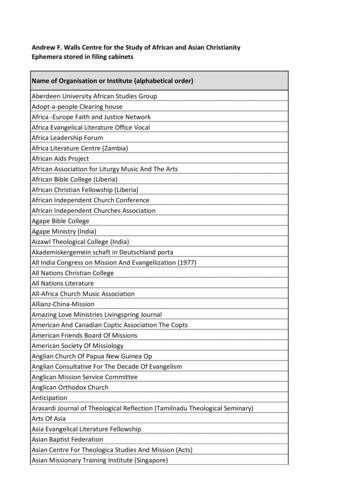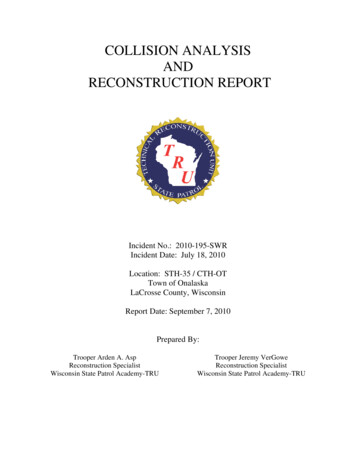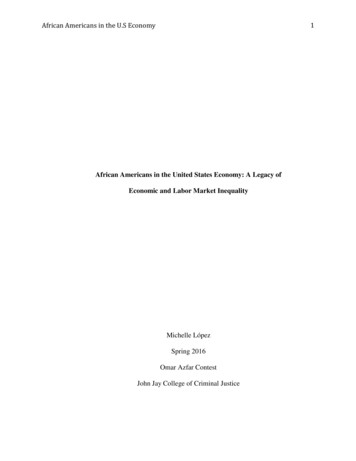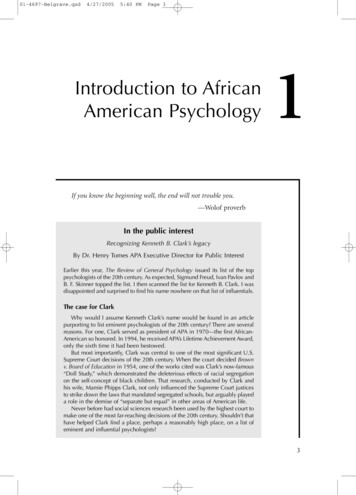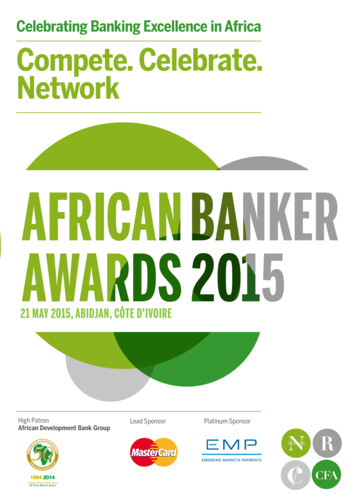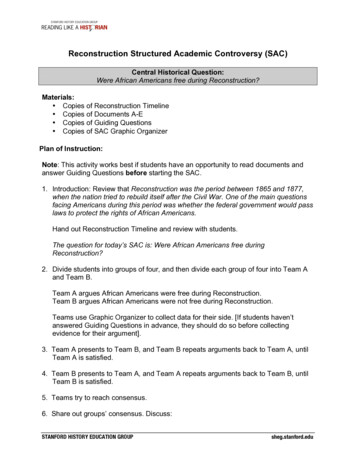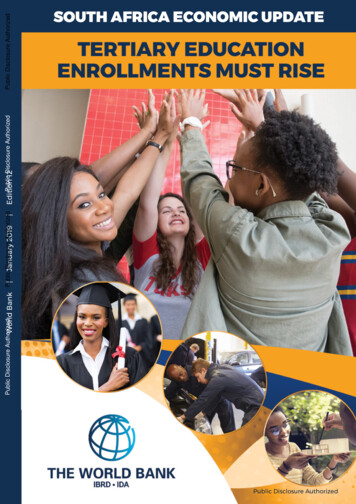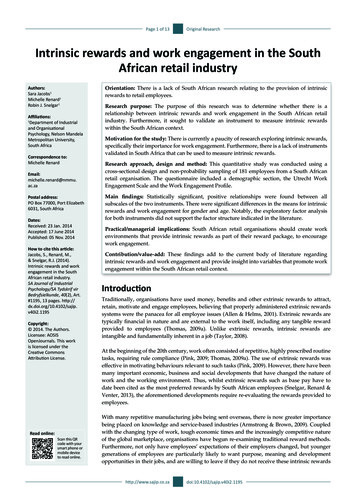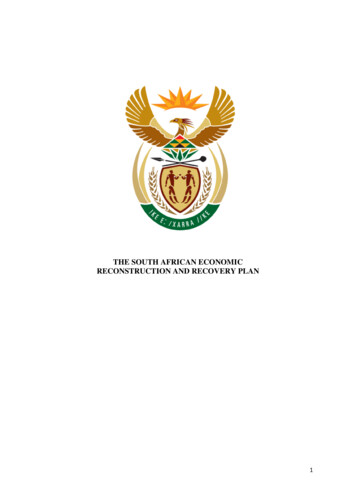
Transcription
THE SOUTH AFRICAN ECONOMICRECONSTRUCTION AND RECOVERY PLAN1
1. INTRODUCTIONThis document sets out a reconstruction and recovery plan for the South African economy thatis aimed at stimulating equitable and inclusive growth. For the past decade, the South Africaneconomy has experienced stagnation which has put a strain in the effort to tackle the historicalstructural inequalities, unemployment and poverty. There is a consensus amongst the socialpartners that there should be substantial structural change in the economy that would unlockgrowth and allow for development. Government’s conviction is that we have to massivelymobilise all our resources and efforts in economic activities that will put the economy in asustainable recovery trajectory.The challenges in the South African economy have overtime been worsened by sustained lowlevels of investment and growth. The economy has also experienced a series of downgrades,including state-owned enterprises (SOEs). This has impacted adversely on the cost ofborrowing. In addition, low levels of growth and challenges related to revenue leakages havealso impacted negatively on resource mobilisation. These challenges, coupled with anincreasing budget deficit and a rising stock of debt has constrained the fiscal space. To breakthe stranglehold of these challenges and other economic constraints, requires a plan that willhelp us take advantage of the opportunities presented by the global economy that is also on themend.The outbreak of the Covid-19 pandemic in March, 2020, found a vulnerable South Africaneconomy. In fact, at the time pandemic reached our shores, the South African economy hadexperienced two consecutive quarters of a recession. As a result, the Covid-19 pandemicdeepened the economic crisis. Many people lost their jobs, many have gone without incomefor extended periods, and many are going hungry every day. Inequality is expected to widenand poverty to deepen. Given the extent of the devastation, the economic response requiredshould match or even surpass the scale of the disruption caused.The stagnation of the economy for a long period coupled with the Covid-19 crisis has also ledto low levels of capacity utilization in the various sectors of the South African economy. Thistrend is projected to continue; painting a dire picture for gross fixed capital formation. Asignificant reduction in the gross fixed capital formation variable is a troubling development;given that this variable is critical in sustaining and growing the productive base of the economy.2
Drastic declines in capacity utilization also imply that investment plans and projects that wereaffordable before the impact of the crisis face the possibility of not being affordable with aprolonged subdued capacity utilization.However, in adversity so often comes opportunity. South Africa is now on the threshold of animportant opportunity to imaginatively, and with a unity of purpose, reshape its economiclandscape. The current conjuncture presents an opportunity to reset the South Africaneconomy. It is an opportunity to build a new, inclusive economy that benefits all SouthAfricans. This is a moment for a permanent and decisive break with our past of low anddeclining growth, falling per capita incomes, low investment, as well as high and deeplyentrenched levels of inequality, poverty and unemployment.Fundamentally, there is a consensus amongst social partners that to generate growth andinclusive development, within the context of the South African historical trajectory, requiresan exceptional form of state, a capable state. A capable state is an important enabling factorwithout which this plan will not achieve our determination to revive the economy. PresidentCyril Ramaphosa communicated our determination as a country in responding to the Covid-19crisis when he said: “We are determined not merely to return our economy to where it wasbefore the coronavirus, but to forge a new economy in a new global reality.”The South African Economic Reconstruction and Recovery Plan has three phases: Engage andPreserve - which includes a comprehensive health response to save lives and curb the spreadof the pandemic; Recovery and Reform - which includes interventions to restore the economywhile controlling the health risks; and lastly, Reconstruct and Transform - which entailsbuilding a sustainable, resilient and inclusive economy. In terms of the Plan, the followingpriority interventions will be made: Aggressive infrastructure investment; Employment orientated strategic localization, reindustrialization and export promotion; Energy security; Support for tourism recovery and growth; Gender equality and economic inclusion of women and youth; Green economy interventions; Mass public employment interventions; Strengthening food security; and Macro-economic interventions3
To ensure the successful implementation of the Plan, the following key enablers will be put inplace: Resource mobilisation; Regulatory changes, a supportive policy environment and enabling conditions for easeof doing business; Building a capable state; Social compacting; Skills development; as well as Economic diplomacy and further integration into the African continentIn addition, specific interventions in sectors that have emerged as important areas of growthand employment will be made to strengthen the economic reconstruction and recovery.Interventions in the Plan will be underpinned by the need to protect vulnerable workers,households and firms; build consumer, investor and public confidence; deepen industrializationthrough localization; pursue environmental sustainability, deliver quick wins; and continueproviding relief to mitigate the impact of Covid-19. Ultimately, the end goal is to pursue andinfrastructure led economic reconstruction and recovery with investment in infrastructure thatwill stimulate the various sectors of the economy.To support economic reconstruction and recovery, the following structural reforms will beimplemented: Modernizing and reforming network industries and associated state owned enterprises; Re-orienting trade policies and pursuing greater regional integration to boost exports,employment and innovation; Lowering barriers to entry to make it easier for businesses to start, grow, and compete; Supporting labour-intensive sectors such as tourism and agriculture to achieve moreinclusive growth; Creating greater levels of economic inclusion, including through addressing high levelsof economic concentration; Addressing the weak job-creating capacity of the economy; Boosting education and skills development; Promoting greater beneficiation of raw materials; and Addressing racial, gender and geographical inequalities which hamper deepereconomic growth and development.4
In the final analysis, the reconstruction and recovery plan seeks to build a South Africaneconomy that meets the needs of all its citizens. An economy that will create enough jobs forall who seek employment, provide equitable distribution of income amongst all South Africansand create a better life for all.2. FRAMING THE PROBLEM – SUPPLY AND DEMAND IMPACTSSouth Africa faces persistent challenges ofinequality, unemployment and poverty.These challenges have overtime beenworsened by sustained low levels ofinvestment and growth. The South Africaneconomy experienced two consecutivequarters of negative growth prior to theintensification of the impact of theCOVID-19 crisis on the economy. Theunemploymentratehasremainedstubbornly high and has been increasing prior to the impact of the crisis permeating throughthe South African economy. The economy has also been experiencing a series of downgradesincluding for SOEs, thereby making the cost of accessing funds for funding criticalprogrammes of government expensive.Figure 1: The fiscusThe increase in the risk premium as a result of an increase in downgrades has also had anadverse impact on the public debt servicing costs. It is also important to indicate that the5
primary budget deficit has been increasing over time, and that the stock of debt has also beenrising thereby leading to a constrained fiscal headspace. The COVID-19 crisis found the SouthAfrican economy battling with the effects of structural problems. The crisis has led tosignificant adverse impact on capacity utilization for various sectors of the South Africaneconomy, this has also been accompanied by significant decreases in gross fixed capitalformation in the first quarter of 2020 compared to the same period the year before.The economy has also experienced significant employment reduction or redundancy effectsacross various sector of the economy. The current epidemiological scenarios and projectedscenario impact on health, critical economic variables, the livelihood of the people and the lowbase from which to build the economy paint a picture that will require radically differentmeasures to mitigate against the impact of the crisis.The current conjuncture presents an opportunity to reset the South African economy. It is anopportunity to build a new, inclusive economy that benefits all South Africans. This is amoment for a permanent and decisive break with that past of low and declining growth, fallingper capita incomes, low investment, as well as high and deeply entrenched levels of inequality,poverty and unemployment. This is a definitive moment not only to address the weaknesses ofthe pre-COVID-19 economy, but also and more importantly to create an environmentsupportive to sustained and accelerated economic recovery.Figure 2: South Africa’s GDP performance (2014:Q1 – 0 2.83.41.72.0Percent3.2-2.7-0.8-1.4-2.0-3.2Q1 Q2 Q3 Q4 Q1 Q2 Q3 Q4 Q1 Q2 Q3 Q4 Q1 Q2 Q3 Q4 Q1 Q2 Q3 Q4 Q1 Q2 Q3 Q4 Q120142015201620172018201920206
Data Source: Statistics South Africa, 2020A response to the economic impact of COVID-19 calls for interventions that also address thestructural problems that beset the South African economy prior to the impact of thecoronavirus. This means crafting interventions that bring about an outcome that decisively dealwith the impact of the coronavirus on the South African economy and the last standingstructural challenges that have been inhibiting the type inroads that we needed to have made asan economy and a people.Figure 3: Framing the problem7
Figure 4: Cornerstones of the reconstruction and recovery plan8
Figure 5: Phases of the Economic Reconstruction and Recovery effortSpecific short, medium and long-term interventions required to strengthen key sectors of theeconomy will also be made. The collective impact of these sectoral interventions are intendedto bring South Africa back on course towards the targets set in the National Development Plan;Vision 2030. These include: Growing the economy at a rate of 5,4%; Reducing the unemployment rate to 6%; Increasing investment as a share of GDP to 30%; Reducing inequality as measured by the Gini Coefficient to 0.60; and Total eradication of poverty.It is acknowledged that the attainment of Vision 2030 and these targets have been made moredifficult by the COVID-19 crisis. This presents a challenge which must be met through a9
redoubling of efforts to put the economy back on track after the blow dealt to it by the crisis,and to place it back on the track towards the trajectory of Vision 2030.3. PRIORITY INTERVENTIONS3.1 Infrastructure investment and deliveryInfrastructure investment, delivery and maintenance will play a leading role in South Africa’seconomic reconstruction and recovery. A large-scale infrastructure programme will boostaggregate demand, assist in reviving the construction industry and contribute to employmentcreation. Efforts will be strengthened to attract private sector investment in the delivery ofinfrastructure as part of building broad-based Public, Private Partnerships (PPP). This willinclude a review of the PFMA and the MFMA to facilitate PPP.The infrastructure delivery programme will prioritise network industries to support a long-termincrease in the productive capacity of the economy with the potential to crowd-in additionalprivate sector investment. As part of prioritizing infrastructure development for networkindustries, the modernization of freight and public transport will receive immediate attention.In this regard the following will be implemented: Reversing delays in Metrorail modernization including prioritizing the refurbishmentof the Mabopane line in Tshwane and the Central line in Cape Town; Ensuring improved efficiencies at ports of entry; Protecting passenger and freight rail infrastructure from vandalism, arson and othercrimes; Fast-tracking the approved Integrated Public Transport Networks in 5 Cities, providingsupport to the taxi industry, the development of the small harbors project and the rollout of a labour intensive rural roads asset network using alternative technologies as wellas local supply and value chains.In the delivery of infrastructure local industries will be privileged. The empowerment ofwomen, young people, persons with disability and military veterans will also be strengthenedin a manner that fosters competitiveness and resilience. This will include the development oflocal supplier industries for infrastructure delivery.Attention will also be paid to improving the state’s technical, project preparation and financialengineering capabilities, including through drawing-in private sector skills and expertise, to10
fast-track the delivery of infrastructure projects. A single window of entry will be createdthrough the establishment of Infrastructure South Africa (ISA): a central government agencyresponsible for coordinating and driving the infrastructure investment programme. This willhelp fast-track the delivery of projects.To further strengthen state capacity for infrastructure expansion the following will beimplemented: Standard design for social infrastructure; Designate the DBSA and Coega to be implementing agents for certain key projectswhere there are capacity constraints; Reinforce the Municipal Infrastructure Support Unit as it is in the area of municipalinfrastructure where there are the greatest capacity issues; Improve coordination with provinces to introduce preparation capacity, whilst alsoworking strengthen overall infrastructure capacity; Allow greater allocation to project preparation and packagingFigure 6: Reviews to be undertaken3.2 Industrialisation through localisationTo kick-start a massive programme of industrialisation through localisation, certain localindustries where localisation will be driven aggressively will be supported with special11
measures including through a strong link with infrastructure investment plans. These includethose sectors located in economically depressed areas; those able to create large numbers ofjobs, including low skills jobs; industries where South Africa already has existing capacity ora competitive advantage as well as industries that support innovation.Working capital loans at 0-2% interest to assist firms during start-up phase will be madeavailable. This is set to benefit the introduction of SMMEs in the value chains of our economy.The infrastructure delivery programme will be linked to the programme for industrializationand localization.Overall, the programme to drive industrialization through localization will seek to achieve thefollowing strategic objectives: Reduce the proportion of imported intermediate and finished-goods; Improve the efficiency of local producers; and Develop export competitive sectors that can expand the sales of South African madeproducts on the continent and beyond.Priority will be placed on key value chains such as in construction; agro-processing; healthcare; basic consumer goods; capital goods including equipment and industrial inputs used ininfrastructure projects; and transport rolling stock focusing on automobile and rail assemblycomponent production.The programme for industrialization through localisation will be buttressed by the strictenforcement of measures to curb illegal imports which continue to remain a challenge for thelocal manufacturing industry. Interventions through this programme will place inclusivity atthe centre in a manner that fosters competitiveness and resilience such that we at the same timebuild a productive base for the export market. The programme will also include importreplacement measures covering critical medical equipment, health stocks/APIs and key foodproducts.Support for the local beneficiation of minerals, the building of minerals value chains andstrengthening broad-based industrialization will be prioritized. Linked to this is theidentification of strategic minerals that will be designated for local beneficiation.12
Special Economic Zones will be used to maintain the investment pipeline momentum in theshort term. Government will also work with the private sector in order to enhance thelocalization of their supply chains as a critical short to medium term intervention that will besustained.A focused manufacturing programme will be implemented to build and support SMMEparticipation in the manufacturing value chain for purposes of localization based on thefollowing principles: Accelerating the involvement of township and rural enterprises in the manufacturingvalue chain; Intensifying SMME participation in the light and fast consumer goods manufacturing; Facilitating the participation of SMMEs in the high-demand minerals beneficiation,such as chrome and ferrochrome; and Revitalizing dormant industrial production infrastructureFigure 7 presents the extent of localization in various subsectors of the manufacturing sectorin the South African economy. This provides a good base from which government will intensifylocalization focusing on the top export basket list, critical inputs for the industrialization andfor domestic consumption. To this end, government will aggressively support localization thatis guided by these three areas in a manner that improves the competitiveness and resilience ofthe manufacturing sector.Figure 7: Industrial localisation13
State procurement will shift decisively to local procurement, while enforcement of localprocurement requirements will be strengthened. The weight placed on pricing will be reviewed toenable deeper levels of local procurement. Competition policies will be utilised to ensure that thestate does not face unreasonable pricing.Centralised procurement will be used for all identified products, with transversal contracts toenable long-term procurement commitments with reciprocal commitments by manufacturers totransformation, investment and pricing.The different tools available to the state, all public entities and the three spheres of government;including industrial funding, tax incentives, licensing, tariffs and others public measures will bereviewed to enable conditionalities to be placed for localisation. The implementation of the exporttax on scrap metal will be speeded up to enable foundries and steel mini-mills to recover and grow.3.3 Energy securityEnergy security is critical for the maintenance of a stable economy and is also important inensuring growth. South Africa’s industrialisation and manufacturing depends on its energyindustry. In addition, the South African energy industry plays a major role in the continental energydemand. However, energy demand in the country and the continent has been growing faster thanthe available supply and that necessitates a further diversification and strengthening of the energypool and capacity through innovation and efficiency.Specific interventions in the energy sector include: Creating a Transmission Company from a Restructured Eskom and facilitating electricitytrading; Securing and additional 550 MW procured by Eskom that will be connected by December2020; Connection of additional 128 MW of IPP capacity; Connection of Bid Window 4 IPP capacity, 1338 MW between January and June 2021 and279 MW by March 2022; Enabling additional capacity through section 34, to unlock 2 000 MW; Prepare for the nuclear programme at the pace and rate that is affordable;14
Finalise model and partnership for the LNG Import Architecture and Partnership within 6months in order to unlock investment and value; Enable Upstream Sector Investments, through the finalization of the Petroleum ResourcesDevelopment Bill and related fiscal measures; Finalise the Bioenergy regulations in the short term; Implementing price and market regulatory changes to increase usage of LPG as analternative energy source for heating and cooking; Issuing a request for qualification on the gas to power programme; and Enabling generation for own use.A critical part of securing South Africa’s energy future, is the need to intensify regional integrationefforts; whether for access to gas in cases where neighbouring countries are endowed, or for thedevelopment of new regional generation and transmission infrastructure where needed.Some of the immediate interventions to secure South Africa's energy future include separating andunbundling Eskom, improving efficiency, monitoring the Eskom build programme and reliabilityof energy supply, reviewing progress with the minimisation of load shedding trends andidentifying potential opportunities for Eskom on the continent to support regional development.The Framework Agreement for a Social Compact on Supporting Eskom for Inclusive EconomicGrowth is critical component of ensuring security of energy supply as well as the operational andfinancial stabilisation of Eskom.The implementation of the Integrated Resource Plan will ensure the diversification of SouthAfrica’s energy sources which also embraces new entrants and capacity into the energy space.Government will continue to explore the conversion of old power stations that are to bedecommissioned with proximity to Mozambique for gas conversion.3.4 Gender equality and economic inclusion of women and youthThe interventions that form part of the South African Economic Reconstruction and Recovery Planwill be geared towards promoting greater participation by black people, women, youth and personswith disability at all economic levels. This will be done as part of transforming patterns of assetownership and income distribution in our society. Government will ensure effective gendermainstreaming in all aspects of the Plan, through the participation and mobilization of women at15
all levels. This includes such mechanisms as the 40% set aside for women in public procurement,legal remedies to close the gender pay gap, women’s participation in key economic sectors, accessto assets such as land, and women’s financial inclusion and empowerment.In the infrastructure built programme, South African companies and building materials will beused, as well as labour intensive construction methods; placing emphasis on skills transfer, theempowerment and inclusion of young people, women and persons with disability. SMMEs,especially those run by the young people, women and persons with disability will play a significantrole in the delivery of the infrastructure necessary to catalyze economic recovery andreconstruction.Young people, women and persons with disability will be encouraged and supported to formcooperatives in key economic sectors such as retail, agriculture and agro processing, financialservices (Cooperative Financial Institutions), manufacturing and infrastructure development. Inaddition, young people, women and persons with disability will be prioritized in accessing fundingfor initiatives that will drive the recovery and reconstruction effort.As part of building the skills base required by our changing economy, young people, women andpersons with disability will be provided with tools and training to enable them to access onlinelearning and economic opportunities. Linked to this will be the re-orientation and alignment of theskills strategy to be more demand led and responsive to the changing nature of work, includingprioritising the up-skilling of women and girls with due regard to reversing the deterioration of thegender division of labour;3.5 Support for the recovery and growth of the tourism, cultural and creative industriesThe tourism, cultural and creative industries were among the hardest hit by COVID-19.Accordingly, efforts aimed at ensuring these sectors’ recovery and growth will form an integralpart of the overall reconstruction and recovery effort.The tourism industry is a growth focal point, able to absorb varying skills levels throughemployment. Industrial linkages of the sector have important implications for the generalstimulation of South Africa’s economy through the multiplier effect from the expenditure side,and the fall in demand of related sectors such as agriculture, transport, petroleum industry has16
started filtering through the economy. Gross value addition in this sector is rooted in its value chainthat has a strong relationship and linkages with other sectors of the economy.Government has developed a tourism recovery plan which identified three recovery phases: Protectand Rejuvenate Supply, Re-ignite Demand and Strengthening the enabling capacity in the sector.The interventions in the first to third row indicate interventions per area of focus over timeovertime:Immediate measures to protect the supply side capacity of the tourism sector will be introduced.These are indicated in Figure 8 below.17
Figure 8: Immediate measure to protect supply side capacity of tourism sectorThey include cooperation with neighbouring destinations towards a regional value proposition anda seamless visitor experience will be prioritized. Attention will also be paid to catalysing domestictourism demand through the phases of economic re-opening with informative and inspirationalmessaging that encourages safe tourism and domestic vacation experiences. Further attention shallbe given to the maintenance of attraction to prevent the collapse of the tourism supply base.The Department of Tourism will continue to work with sister departments to build on the workalready done to increase ease of access into South Africa for the purposes of stimulating theinternational tourist market. In particular, the e-visa programme and visa waivers where possiblewill be implemented. The Development and implementation of globally recognized bio-diversityprotocols and support for the biodiversity economy will be strengthened.SMME funding in the tourism sector will be directed in a manner that deepens the spatial tourismsubsector product offerings in villages and small towns. Sector transformation aimed at facilitatingparticipation of black people, especially women shall also be facilitated through implementationof Tourism Equity Fund.To support the revival and sustained growth of the cultural and creative industries in the COVOD19 era, interventions will be made to strengthen the development of online platforms for thedistribution of creative products and where they exist these will be strengthened. Linked to this18
will be interventions to strengthen, including through the introduction of appropriate incentives,online dissemination of cultural products such as music, film and design.To unlock both the demand and supply side constraints in the cultural and creative industries, thefollowing focus areas will be prioritized: Stimulation of demand; Audience development and consumption; Support the development of local content, including digital content; and Develop cultural value adds to the tourism packages and enhance the profile of thecoordinated value proposition.3.6 Green economy interventionsThe pursuit of green industrialization and a green future is an important intervention not only inaddressing the persistent challenges of inequality, poverty and unemployment, but also in offeringa sustainable solution to climate vulnerability and driving economic competitiveness. Greenindustrialization also guarantees the security of energy, food, water and electricity supply.Accordingly, South Africa’s economic reconstruction and recovery effort will include a significantgreen component. This will help in creating new green jobs, industries and firms.Pursuing green industrialization also has added advantages as follows.19
Figure 9: Advantages of Green IndustrialisationExpanding the programme to retrofit public and private buildings with measures to improve energyand water efficiency, will form a major part of South Africa’s green agenda. The extension of thisprogramme to schools, human settlements, clinics and other public buildings has a potential tobuild a local industry that is labour intensive and anchored on a sustainable value chain thatsupports SMME participation, income generation by households and skills development forunemployed youth.In the energy sector the retrofitting of the aging Mpumalanga power stations with solar powercould save jobs, sustain livelihoods and ensure that important grid infrastructure is revitalized.Also of significance is that the economy transitions to towards a greener future, care will be takento ensure the principle of a just transition. Critical interventions in the green economy includeamongst others the following high impact priority areas: Biodiversity economy infrastructure roll out inclusive of Protected areas; Support for SMMEs and cooperatives to take advantage of opportunities in the greeneconomy; Implementation of exclusion applications for 48 sites for ash, gypsum, slag and biomassbeneficiation; Support for small grower farmers through PPPs in forestry, including in state plantations20
Support for Traditional Authorities Demonstration Project; Waste picker integration and revitalization of buy-back centres; Section 18 industry waste management plans; and Intermediary solutions for aquaculture products, and revitalisation and upgrade of existinggover
This document sets out a reconstruction and recovery plan for the South African economy that is aimed at stimulating equitable and inclusive growth. For the past decade, the South African economy has experienced stagnation which has put a strain in the eff ort to tackle the historical structural inequalities, unemployment and poverty.
